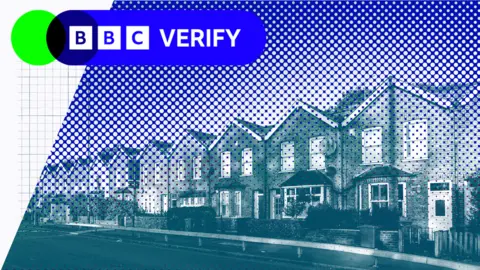England’s most deprived areas named – see how your area is affected
2 hours agoChristine Jeavans and Phil Leake,data journalists, BBC Verify

 Getty Images
Getty ImagesJaywick, near Clacton-on-Sea in Essex, has been named the most deprived neighbourhood in England for the fourth consecutive time since 2010, new data shows.
Seven areas in Blackpool are also among the 10 most deprived, alongside one in Hastings and one in Rotherham, according to the Ministry for Housing, Communities and Local Government (MHCLG).
Half of the neighbourhoods in Middlesbrough are very deprived, making it the council with the highest proportion, ahead of Birmingham and Hartlepool.
The minister for local government and homelessness, Alison McGovern, said the figures were an indictment of previous policies and the government was “tackling the root causes of deprivation head on”.
The Index of Multiple Deprivation looks at living conditions across an area – but does not mean that everyone in a highly deprived neighbourhood will be struggling, nor will all those in a less deprived area be well off.
The figures published on Thursday do not show whether an area has become better or worse off since the previous report, but instead show patterns of how areas have changed relative to each other.
Deprivation is spread across the country, with 65% of local authorities containing at least one highly deprived neighbourhood, up from 61% in 2019.
A neighbourhood to the east of Jaywick was again found to be the most deprived having previously topped the list in the last three reports, released in 2010, 2015 and 2019.
Clacton MP Nigel Farage, whose parliamentary constituency includes Jaywick, told the PA news agency he was “obviously sad that things aren’t improving more quickly”.
He said he believed he had “definitely helped” tourism in the area, with “having a high-profile MP helping to put Clacton on the map”. But he added: “I’m doing what I can, but there’s a limit to what one person can do.”
The MHCLG found 82% of areas found to be the most deprived in 2025 were already in that category in 2019.
The department used a number of weighted metrics to determine a neighbourhood’s level of deprivation, including income, crime and barriers to housing.
They are then assessed as more or less deprived compared to other neighbourhoods.
Middlesbrough has the highest percentage of very deprived neighbourhoods for income, education and crime, while Hartlepool tops the list for employment.
Liverpool has dropped out of the top 10 overall despite ranking second in 2019, but it still fares worst for health with more than 60% of its neighbourhoods classed as highly deprived.
The report also found that Tower Hamlets and Hackney in London had the highest levels of income deprivation among households with children.
Meanwhile, nine of the 10 local authority districts with the highest levels of income deprivation among older people are in London.
There are pockets of deprivation surrounded by less deprived areas in every region of England, but highly deprived places are most concentrated in the north and the midlands.
More than one in five neighbourhoods in the North East and the North West are in the most deprived category, compared with around one in 25 in London, the South West and the East of England, and one in 33 in the South East.
England’s least deprived neighbourhood is in the town of Harpenden, near St Albans in Hertfordshire.
The report is the latest in a long-running series that are used by central and local government and other bodies to target resources for local services.
The government’s recently announced Pride in Place funding – offering “overlooked” communities a share of £5bn – was allocated in part based on the deprivation figures from 2019.
Areas with a history of heavy industry or mining are particularly affected, the report’s authors highlight, along with parts of East London and several coastal towns including Jaywick.
The former holiday resort was visited by the UN special rapporteur for extreme poverty as part of a fact-finding mission in 2018.
And last year, its local district council, Tendring, agreed a £126m 20-year improvement plan.
Parts of Jaywick very depressed, says Farage
The latest data highlights “the scale of the challenge” but does not “reflect the progress made since 2019 or the strength of the people who call Jaywick Sands home”, Tendring District Council said in a statement.
Council leader Mark Stephenson described Jaywick as a “truly special place” and called on the government for extra funding.
Speaking to the BBC, local resident Christopher Thompson, 60, said: “[Jaywick] is deprived, it needs investment, there is nothing here for the kids.
“The community is amazing – amazing people down here, they all help each other out.”

 Henry Godfrey Evans / BBC
Henry Godfrey Evans / BBCGovernment minister McGovern said the statistics were a “damning indictment of a system that has left some communities broken, councils pushed to a financial cliff edge and residents facing the brunt of service cuts”.
Previous policies had “barely begun to break the cycle of deprivation,” leading to stagnant local growth and “loss of hope”, she said.
McGovern added the government was “tackling the root causes of deprivation head on” by investing £500m in children’s development, extending free school meals and a new £1bn crisis support package across the UK.
The previous Conservative government also used deprivation figures, along with other criteria, when deciding where would receive “Levelling Up” grants.
Scotland, Wales and Northern Ireland also have Indices of Multiple Deprivation which are each published separately. No dates have yet been announced for these updates.
How is deprivation measured?
The Index of Multiple Deprivation ranks all of England’s 33,755 neighbourhoods, each with an average of 1,500 people, by their deprivation score.
The score is calculated from data on income, employment, education, crime, health and disability, barriers to housing and services, and the living environment.
Once all the neighbourhoods are ranked, they are split into 10 equal groups called deciles, where the first decile is the 3,375 most deprived neighbourhoods and so on.
We are using terms like “highly deprived” and “most deprived” to refer to this group of neighbourhoods. There are areas of deprivation throughout England and not everyone in a neighbourhood will experience deprivation equally.
Additional reporting by Jess Carr, Libby Rogers and Lucy Dady
More on this storyDepartment for Levelling Up, Housing and CommunitiesEngland